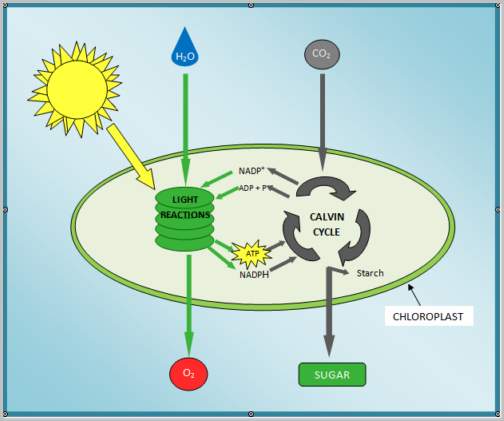Photosynthesis is defined as the conversion of CO2 to carbohydrates using reaction that utilizes light and water.

Photosynthesis is divided into two steps. These steps are firstly: the light reaction and secondly the dark reaction. In the light reaction the synthesis of energy rich molecules such as ATP from light and water is performed. In the same reaction another important compound NADPH is produced. NADPH is a reducing molecule that is used in the metabolism of different compounds.
The second step in the photosynthetic pathway is called the dark reaction. In this step there is a conversion of CO2 and water to carbohydrates. This second step does not need light in order to proceed. Therefor it is called the dark reaction.
The first step of photosynthesis which generates energy rich molecules is called the light reaction because it needs light in order to proceed.
There are some bacteria that are able to live on photosynthesis. These bacteria are called phototrophs. One of these bacteria is called cyanobacteria and another phototroph is called: purple bacteria.
In eukaryotes there is a special organelle in them that is responsible for the photosynthetic process. This organelle is called the chloroplast. This organelle contains within it a membrane that is called the thylakoid membrane. This membrane is the site of production of ATP and NADPH in the light reaction of photosynthesis.
The molecule in the chloroplast that is responsible for capturing the light is the chlorophyll. This molecule contains conjugated system of double bonds which helps in absorbing the sun light.
In addition to producing ATP and NADPH, photosynthesis is also responsible for the synthesis of oxygen or O2 which is used for aerobic respiration to produce energy in the form of ATP.
Metabolism in general is powered by energy rich molecules. These are ATP and NADH and NADPH and ubiquinol. These energy rich compounds are used as energy source to drive the production or synthesis of proteins, carbohydrates and nucleic acids. These compounds are important for the normal functioning of the cells.
The formation of carbohydrates in the dark reaction of photosynthesis occurs in the stroma of the chloroplast. It is done by a a cycle of reactions catalyzed by enzymes. These reactions result in the fixation of CO2 and the synthesis of carbohydrates. In addition to the production of oxygen or O2.
This process unfortunately have various names to it which can be confusing for the reader. These names are firstly: It is called the reductive pentose phosphate cycle. Another name to the same process is the C3 pathway. The third name to this process is called the photosynthetic carbon reduction cycle. Often this cycle is also called the calvin cycle.
All plants have the ability to convert carbon dioxide or CO2 by the reductive pentose phosphate cycle to sucrose in the cytosol of the cell. It has also the ability to synthesize starch in the chloropast. In addition it synthesizes cellulose in the cell wall.
Sucrose is synthesized in the cytosol from glyceraldehyde 3-phosphate and dihydroxyacetone. Glucose in the cell is converted to trios-phosphate using the process of glycolysis. In some other plants other cycles of CO2 fixation is found in addition to the reductive pentose phosphate cycle and thus minimizing photorespiration.
The fixation of CO2 which is the first step in the reductive pentose phosphate cycle is catalyzed by an enzyme that is called RUBISCO which is short for ribulose 1,5 bis phosphoate carboxylase oxygenase.

